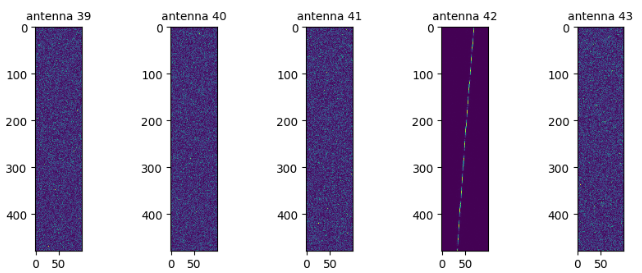Rise of the Arrays
It’s been a little while since I blogged about analyzing radio signals so I thought I’d write a bit more about what I’ve been up to.
Behold: stamps!

Stamps?
A stamp is the casual name for the input data from a radio telescope array, with a separate reading for each antenna, in a small range of frequencies, where a first pass on the data saw “something interesting”. This data is stored as complex voltages, because it’s basically a voltage going through a wire in a sensor, but you can graph its magnitude as yellow = strong signal, blue = weak signal, and that’s what I’m showing here.
This data is from the MeerKAT telescope in South Africa. Right now, the way this system works is roughly that every five minutes, the telescope records 60TB or so of data. We do a pass over the data to look for interesting stuff, and then when we find interesting stuff, we save a little neighborhood of relevant data in the “stamp”.
What is a Radio Telescope Array?
When I say “radio telescope”, think a big dish that looks like a satellite dish but it’s like 40 or 300 feet across. Not the sort of telescope you look into with your eyes. When I say “radio telescope array” think a whole bunch of these big dishes in a flat desert in the middle of nowhere.
Why Radio Telescope Arrays?
You can see that in this data, antenna 42 is showing “something”, and the other antennas are showing “nothing”. Unfortunately, that means this is not aliens. An alien signal would be coming from very far away, so it should show up pretty similarly in all the different antennas.
This is useful data to have, though! “Traditionally”, i.e. in most radio telescope searches for aliens in the years 1990-2020, the best method for distinguishing alien signals from other stuff has been to look at the shapes on these charts.
-
Big blob: a wide-band radio signal, could be a pulsar, quasar, interference
-
Vertical line: an artificial signal moving in unison with the receiver, i.e. on Earth, so it’s interference not a signal
-
Diagonal line: maybe an alien!
The biggest problem with these searches is that diagonal line does not necessarily mean alien. It just means a radio signal from a source that is not sitting still on the surface of the earth. We have tried to get around this by doing a “cadence analysis”, i.e. moving the telescope to point in different directions, and seeing if that makes the signal go away. This doesn’t get rid of everything, though, because sometimes a signal will just appear and disappear because it’s faint.
The array is cool because now we have a new, very powerful way to analyze signals - we can compare how the different antennas recorded the same event.
Wow?
Back in the 70’s, the Wow signal got people excited that maybe we were sensing an alien signal. That signal was about 30 times stronger than baseline noise. But, nowadays we pick up signals that strong all the time. Just turn on your radio telescope, wait five minutes, and you’ll probably see a couple of them. The sample signal I pasted above is about that strong.
Yeah, there’s a lot more radio interference out there nowadays. Still, it seems pretty clear to me that the Wow signal was some sort of radio interference. We didn’t have any strategies at all, back then, for differentiating narrow band interference from real alien signals. Academia isn’t really set up to clearly communicate information like, “In the past fifty years, it’s become slowly obvious to most practitioners that Theory X is incorrect.” If it was set up that way, though, I think the general consensus nowadays would be that the Wow signal was just terrestrial interference.
Complex Numbers
Radio telescope arrays are not just redundant copies pointing at the same thing. They also have very precise timing measurements. It’s precise enough that you can tell when a radio signal arrives at one antenna slightly before arriving at the other antenna. You can use this to very precisely determine of the precision of an astronomical radio source, like a pulsar.
Not only do you have two real numbers that are supposed to be very close to each other for a real signal, you have two complex numbers that are supposed to be very close to each other for a real signal.
This lets us, in theory, differentiate between a signal that is coming from a local source like an airplane or a satellite or a cell phone, versus a signal that is coming from extremely far away, like an alien planet.
Now What?
Well, our system is operational on MeerKAT and recording stamps. We now have far too many stamps to analyze them with our current set of tools. So we’ll need some better tools….